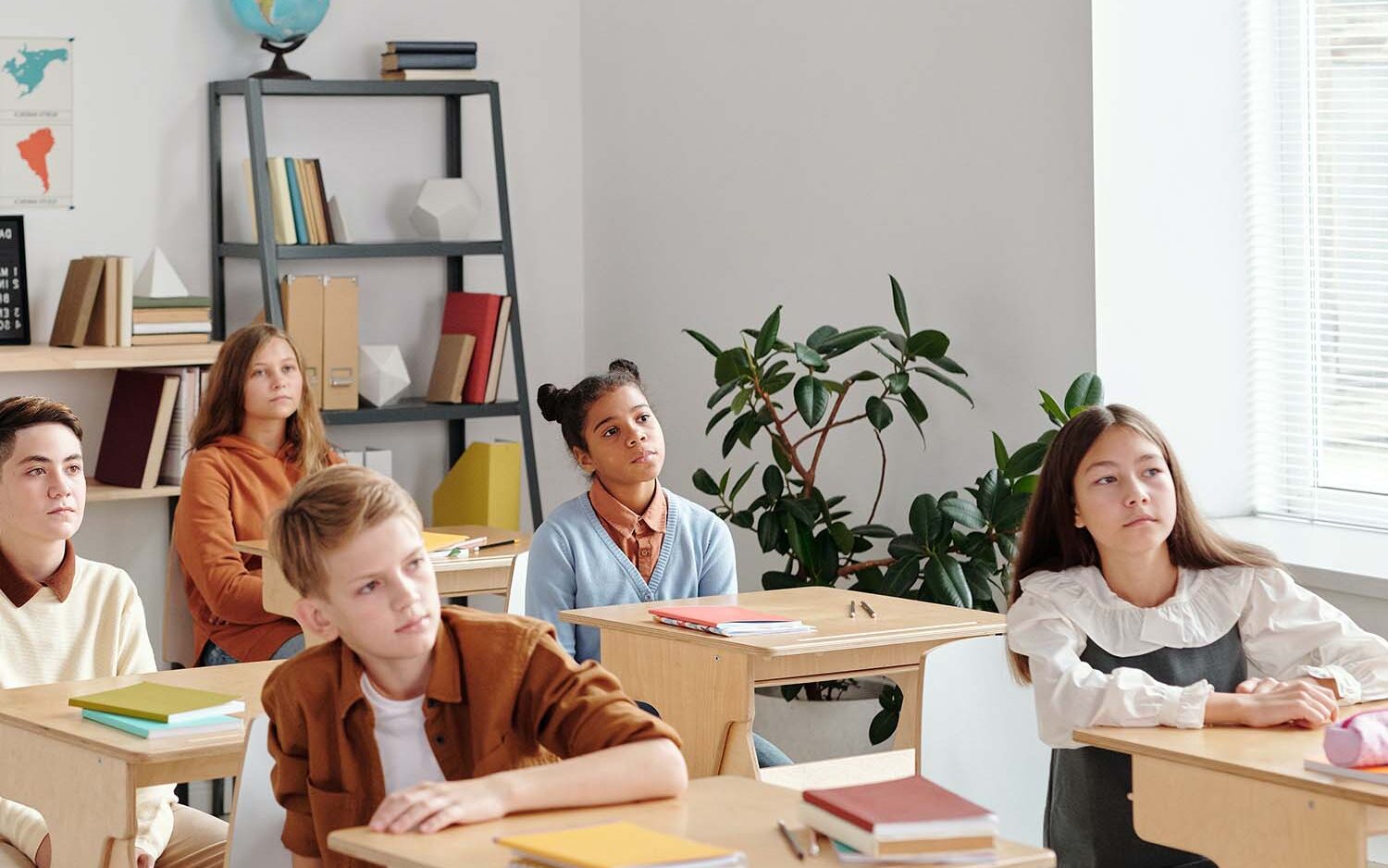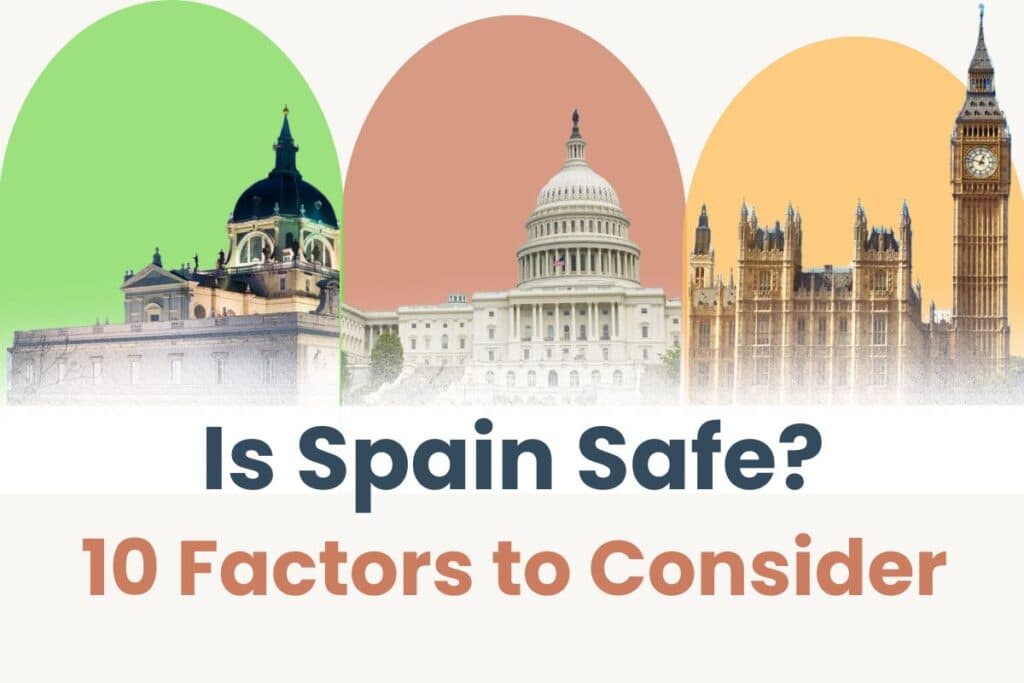There are many things to get right when considering your move to Spain. If you have a family, none is more important than choosing the best school for your child. This guide is part of our Education in Spain series. It can be read standalone or in conjunction with the other guides, especially Education in Spain >> An Easy Introduction for Expat Families.
When moving to Spain, it is highly recommended to consult and/or enlist the services of professional experts. One thing we know is that no one person can know everything about all aspects! In this case, we offer a School Search Service that you may find useful.
The Spanish Education System
The Spanish education system provides free and fee-based schooling of generally high quality. School attendance is compulsory for children between the ages of six and 16, with a focus on equity, inclusiveness, and individual attention for educational achievement. The system is decentralized, with the 17 Spanish autonomous communities managing and delivering education alongside national education policy.
Your Spain Move Planning Package
No guesswork. Just expert guidance tailored to your situation. Our packages include one-on-one consultations with immigration, tax, and finance specialists—plus access to essential moving tools and direct support from Alastair and Alison.
Structure
The Spanish education system is structured into four stages:
| Educational Stage | Age Range |
| Early Childhood (Educación Infantil) (not compulsory) | 0-3(1st Cycle) |
| 3-6 (2nd Cycle) | |
| Primary (Primaria)(compulsory) | 6-12 |
| Secondary (Educación Secundaria Obligatoria (ESO))(compulsory) | 12-16 |
| Upper Secondary (Bachillerato and Formación Profesional) | 16-18 |
In the first stage, nursery and preschool education attendance is optional. The primary and secondary phases are compulsory. The system includes both public and private schools, with some private schools receiving public funding (concertados schools).
Choosing the Best School in Spain
Characteristics of Top Performing Schools
Several factors characterize top-performing schools in Spain. Most, but not all, are private institutions equipped with better resources and facilities.
Many top schools offer bilingual education in English and other major languages, which helps students prepare for international education. This is complemented by international curricula such as the International Baccalaureate (IB), British, or American curricula.
They tend to focus on individualized learning and student development. These schools typically have state-of-the-art technology and well-equipped libraries and sports facilities.
Top schools often have experienced and qualified teachers and a wide range of extracurricular activities. This fosters a strong sense of community, with students from diverse backgrounds learning and growing together.
| Characteristics of Top Performing Schools in Spain | Private Education |
| Bilingual Education | |
| International Curriculum | |
| Personalized Education | |
| High-Quality Facilities | |
| Experienced Staff | |
| Many Extracurricular Activities | |
| Strong Community |
Public vs. Private Schools: What Expat Parents Need to Know
Public (state) schools are generally free to attend, while international schools require tuition fees.
Around a third of children in Spain attend private or semi-private schools (concertadas). Many expat families choose to send their children to private schools to ensure a smoother transition from their native country and better language support. Having said that, figures show the majority of expats send their children to public schools. This allows children to integrate fully into local life and become fluent in Spanish.
Your decision depends on factors like your length of stay in Spain, the ages of your children, and your priorities regarding learning, language, and integration. So, let’s examine the pros and cons of public and private schools.
Language and Integration into Spanish Life
Public schools are a great option if you plan to stay in Spain for the long term. Your child will learn Spanish and integrate with the local culture and community— arguably quicker than you! If the school is in a region with a co-language (for example, Valenciano), they will also learn this language.
However, this can be challenging for children (especially older ones) who are not fluent in Spanish and have difficulty adapting to a different curriculum. Here, private schools provide more flexibility by eliminating the language barrier with classes in your native language and allowing your child to continue their current curriculum. Private (especially international) schools often have a diverse student body and can provide a more cosmopolitan environment. However, they do not necessarily offer the same level of integration into your local community.
Curriculum
Unsurprisingly, public schools follow the Spanish national curriculum. Private, and especially international schools, offer a variety of curricula.
Facilities and Resources
Here, money talks. Public schools typically have limited resources and facilities compared to their private counterparts, which benefit from private funding.
Higher Education Opportunities
Broadly speaking, public schools prepare students for Spanish national qualifications and the Bachillerato, leading to study at Spanish universities. Private schools steer their students to international qualifications like the IB, which increases their chances of higher education opportunities across Europe and the US.
Teaching Staff and Class Sizes
Public schools typically have Spanish-speaking teachers, while private schools often have teachers from various nationalities, including native English speakers. As is usual with public versus private schools, public school class sizes tend to be larger (around 30 to private school class sizes of 20-24).
Overall, with exceptions, private schools in Spain tend to outperform public schools in academic performance. However, many excellent and well-regarded public schools also provide high-quality education.

International Schools in Spain
There are some 300 international schools in Spain. Like all private schools, they are fee-paying. But some differences set them apart. By definition, they are organized around catering to students from many countries and, as such, offer some distinct advantages for internationally-minded students.
Advantages of International Schools in Spain for Expat Students
The main advantages of attending an international school revolve around language, curricula, resources, and culture.
Language, Teaching Staff, and Facilities
International schools often have teachers from various nationalities, including native English speakers. This allows teaching in English and other languages, such as French, German, or Italian.
Typically, they have better facilities and resources, which leads to a broader and deeper range of extracurricular activities than other private schools.
Curriculum and International Qualifications
As mentioned, international schools offer a variety of curricula. This allows you to choose the one best suited to your child (in both language and education) and provide them with a globally recognized qualification.
At the same time, they provide a cultural environment aligned with your native country. In such communities, your child will mix with other expats. This is helpful if you have recently arrived in Spain and helps maintain ties with your culture.
Selecting the Right International School
When looking for a place to live, the first consideration is location, location, location. Many of the 300 international schools are located in Madrid, Barcelona, and along the Costas (although there are exceptions). If you are not in the area of your chosen school, you may need to consider boarding options.
Curriculum, Qualifications, and Primary Language
Choose a school that follows a curriculum that aligns with your child’s previous education and your future plans. For example, if you plan to move back to your home country, a school that follows the same curriculum as your home country is probably a good choice.
Ensure the school offers the qualifications your child needs for higher education. Some schools offer multiple types of certificates, so it is essential to research the options.
On language most international schools use English or French as the primary language of instruction. However, some schools offer other languages and/or bilingual programs.
Reputation and Results
Research the school’s reputation by consulting reviews and ratings from organizations like The International Schools Database or take a look at our International Schools in Spain review.
International schools in Spain are accredited by organizations—for example, the Council of British International Schools—ensuring they meet standards for language instruction and support. Make sure your potential school is accredited by a recognized education organization in your home country.
Do not overlook visiting the school — either as part of the school’s outreach or arranged by yourself — to meet the teachers, see the facilities, and get a general feel of the place.
And don’t forget word of mouth. Connect with any parent associations for additional help and advice from both expats and Spanish parents. Speak with your fellow expats, especially those with children at the schools you are considering. They have paid for their insights; you will get a reliable opinion!
Fees and Enrolment
Fees vary significantly depending on the children’s ages, location, school record, and reputation. They can range from around €2,000 to over €20,000 per year.
Admission and Enrolment Procedures
Some schools require academic and/or language testing or personality assessments before registration. Be sure to research and understand the procedures and requirements.
Extracurricular Activities and Facilities
Consider the types of activities and facilities available, such as sports, arts, and language courses, to ensure they align with your child’s interests.
Enrolling in Spanish Schools: Practical Steps
Non-Spanish resident children can attend Spanish public schools without restriction. But it can be a complex process.
Private fee-paying schools have a similar admission process to public schools but with some flexibility in admission requirements along with any particular conditions of their own.
International schools often have a more selective admission process, with requirements such as language proficiency tests and interviews.
Navigating the Admission Process – Public Schools
Before you start, you must be a resident of the area you are applying for. Therefore, it is imperative that you have the certificate of empadronamineto (El Padrón). Once you have that done, the following steps will tell you the documentation you need and what you need to do to register your child for a public school in Spain.
1. Determine Eligibility
Ensure your child meets the age requirements for the school and education stage:
- Educación Infantil (second cycle) – Between three and six years old
- Primaria education – Between six and 12 years old
- Educación Secundaria Obligatoria (ESO) – At least 12-years old
- Bachillerato or Formación Profesional education – At least 16-years old
2. Choose the Right School
You can see the public schools in your area by looking at your local council’s (ayuntamiento) website. Ayuntamientos play a large role in public education, so it’s worth researching the education section carefully.
In addition to public school listings with links to the schools, you will find information on school year dates, admission processes (and key dates), and necessary documents.
3. Gather Required Documents
As you would expect, you need several documents to support your child’s application.
| Documents Required to Apply for Public School in Spain | Proof residence (El Padrón) | A must-have document |
| Your child’s birth certificate or passport | ||
| Your child’s birth certificate or passport | If they require one | |
| Your child’s visa | ||
| Medical certificate | If not in Spanish, this must be officially translated | |
| Two passport-size photographs of your child |
4. Submit Applications
This is the first of the two main elements of the process, the second being enrolment (see below). You must submit your application during the enrolment window, which varies in different regions but is generally a specific period between February and April (although it is the first week of June in my area). You can complete the form online and submit applications electronically via your ayuntamiento website.
The form usually allows you to choose multiple schools. It is recommended that you add your second and third choices, as it is possible that you won’t get your first-choice school.
5. Follow Up
Provisional List
Now that you have applied, you must wait until the provisional list of admitted students is published. This takes around a month on average. If your child’s name is not on the list of any of your chosen schools, you can contact the local Comisión de Escolarización, usually through your ayuntamiento. They can provide guidance on what to do next and help resolve any issues.
Final List
If your child’s name is not on the provisional list, it does not necessarily mean they will not be selected. The final list follows the provisional list. You can appeal the decision if your child’s name is not on the final list. This may involve providing additional information or documentation.
6. Enrolment
This is the second of the two main steps. Once your child is admitted, you finalize enrolment by visiting the school and completing the necessary paperwork. Act quickly. You may only have a few days to complete it. In my area, after the Final List is published, you have four days to enroll online. After this, you have to go to the school in person within three days.
7. Confirmation
Once the enrollment process is complete, you will receive confirmation of your child’s enrollment.
Ongoing – School Communication
Once you have enrolled your child, maintain communication with the school. This being Spain, things can change without notice. You wouldn’t want your child to turn up on the second day of term!
Important note: The admission criteria and process will vary by autonomous community. They may also change from one year to the next. Check with your local education department for your area’s current and specific requirements.
Additional Requirements and Differences for Private Schools
Admission Requirements
Private schools may have their own admission rules and requirements, such as interviews, knowledge and language tests, and assessment of academic records.
Application and Enrolment Periods
Private schools may differ from public schools. For instance, if your arrival date means your child misses the public school enrolment window, you can consider enrolling them in a private school until the next public enrolment window opens.
Integration and Support in School
Language Integration
Most schools will offer support to pupils who have a low level of Spanish when they join. Pupils receive several hours a week of individualized or small group instruction to improve their Spanish. At the same time, this helps with integration into the local community and culture. However, the quality and effectiveness of these programs can vary across regions and schools.
Some international schools offer bilingual programs, teaching in both English and Spanish. This helps expat students learn Spanish while continuing their studies. Private and international schools can also provide language clubs.
Extracurricular and Support Services
As you would expect, all schools offer extracurricular activities like sports, music, and various clubs. Private and international schools usually offer a broader range of activities, including subjects such as robotics. They may also offer more opportunities for leadership and community service.
Support in Private and International Schools in Spain
These schools can offer additional support by aligning the curriculum with the pupil’s home country to ensure continuity in education and a smoother transition. They also tend to employ teachers experienced in working with expat students, who provide focused support and guidance.
Recommendations and Resources
Best Schools in Spain in Expat Locations
Public Schools
Spain has approximately 18,000 public schools. Split across the educational stages:
- Educación Primaria: 10-11,000 schools
- Educación Secundaria Obligatoria (ESO): 4- 5,000
- Bachillerato: 2-3,000
Research your local area to find the best schools available for your child. School Finder Spain is an excellent place to start.
Private Schools
Roughly two-thirds of Spain’s top private and international schools are located in areas where many expats live. Here is a selection by region:
| Andalucía | ||
| Type | School | Location |
| International | Colegio Internacional San Francisco de Paula | Sevilla |
| Colegio Inglés San Patricio | Málaga | |
| Colegio Highlands Sevilla | Sevilla | |
| Colegio Internacional Torrequebrada | Benalmádena | |
| Colegio El Centro Inglés | El Puerto de Santa María | |
| Aloha College | Marbella | |
| Private | Colegio El Romeral | Málaga |
| Colegio Cerrado de Calderón | Málaga | |
| Colegio Alminar | Dos Hermanas | |
| Colegio Salliver | Fuengirola | |
| Colegio Ahlzahir | Córdoba | |
| Colegio Atalaya | Estepona | |
| Colegio San Estanislao de Kostka | Málaga | |
| Colegio Ecos | Marbella | |
| Colegio Novaschool Añoreta | Rincón de la Victoria | |
| Colegio La Luna | Mairena del Aljarafe | |
| Colegio de Fomento Tabladilla | Sevilla | |
| Colegio La Presentación | Granada | |
| Colegio Maristas San Fernando | Sevilla | |
| Colegio Mulhacén | Granada |
| Cataluña | ||
| Type | School | Location |
| International | St. Peter’s School | Barcelona |
| Benjamin Franklin International School | Barcelona | |
| The British School of Barcelona | Barcelona | |
| Oak House School | Barcelona | |
| St. Peter’s School | Barcelona | |
| American School of Barcelona | Barcelona | |
| Ágora Sant Cugat International School | Barcelona | |
| Lycée Français de Barcelone | Barcelona | |
| Hamelin-Laie International School | Montgat | |
| La Miranda | Barcelona |
| Madrid | ||
| Type | School | Location |
| International | Colegio Internacional SEK-El Castillo | Villanueva de la Cañada |
| Runnymede College | Madrid | |
| International College Spain | Alcobendas | |
| AlcKing’ss | Madrid | |
| The British Council School | Madrid | |
| American School of Madrid | Madrid | |
| Hastings School | Madrid | |
| Colegio Internacional J.H. Newman | Madrid | |
| Private | Colegio San Patricio | Madrid |
| Colegio Nuestra Señora del Recuerdo | Madrid | |
| Colegio Estudio | Madrid | |
| Colegio Santa María del Pilar | Madrid | |
| Colegio San Ignacio de Loyola | Torrelodones | |
| Colegio Brains | Madrid | |
| Colegio El Valle | Madrid | |
| Colegio Santa María de los Rosales | Madrid | |
| Colegio Retamar | Pozuelo de Alarcón | |
| Colegio Mirabal | Boadilla del Monte | |
| Colegio Fomento El Prado | Madrid | |
| Colegio Los Sauces | Madrid |
| Valencia | ||
| Type | School | Location |
| International | Colegio Internacional Levante | Valencia |
| Caxton College | Valencia | |
| El Plantío International School of Valencia | Valencia | |
| British School of Valencia | Valencia | |
| Cambridge House Community College | Valencia | |
| Iale International School | L’Eliana | |
| Newton College | Elche | |
| El Limonar International School Villamartín | Alicante | |
| Colegio Laude Newton College | Elche | |
| King’s College Alicante | Alicante | |
| Lycée Français d’Alicante | Alicante | |
| Laude The Lady Elizabeth School | Benitachell | |
| Private | Colegio Mas Camarena | Valencia |
| Colegio Inmaculado Corazón de María | Valencia | |
| Colegio Santa Ana | Valencia | |
| Colegio Esclavas del Sagrado Corazón de Jesús | Valencia | |
| Colegio Santa María del Carmen | Alicante | |
| Colegio Inmaculada Jesuitas | Alicante | |
| Colegio Aitana | Elche | |
| Colegio San Agustín | Alicante |
Please take a look at our International Schools in Spain directory for more information.
Community and Parental Involvement
Wherever you educate your child, involvement with their education and school is vital. Arguably, this importance is higher when moving your child from your home country to Spain.
Most public and concertado schools in Spain run parent-teacher associations known as Asociación de Madres y Padres de Alumnos (AMPA). AMPAs inform and advise you about your child’s education and promote your involvement in school governance. They foster relationships within the educational community, conduct educational activities, and generally reinforce the school’s values and objectives. As a positive spin-off, the AMPA also connects you with other parents, which can widen your social network.
When looking at schools, check to see if they have an AMPA. It is not unusual for schools to charge a small annual membership fee to join an AMPA. But the benefits far outweigh the cost — from discounts on school trips to a better educational experience for your child.
Private schools also operate AMPAs but can also opt to communicate directly with parents. If your child’s school does not have an AMPA, you can stay involved by participating in school communications (for example, WhatsApp groups). I would also consider volunteering for school activities and events, participating in school governance where possible, and meeting and speaking with other parents.
Conclusion
Choosing the best school in Spain is a crucial decision for expat families. There is a reasonably wide and good choice in Spain. Your final decision comes down to your approach to education, lifestyle choice, and finances.
Factors such as curriculum, location, language support, and extracurricular activities come into play. More specific ones to you will also arise. If you take away one piece of advice, it’s to be as involved as possible with the school you choose — both during and after your selection process.
By following this guide, you, as an expat parent, can make an informed decision about your child’s education. This will give yo
FAQ
Can International Students Study in Spain?
Yes absolutely. Spain offers a wealth of opportunities for foreign students, including many courses taught completely in English. You may need a Spain student visa.
Do Spanish schools teach in English?
While state-funded schools teach in Spanish or a local language like Catalan, there are many international schools that offer an English-speaking curriculum.
Is it expensive to study in Spain?
Spain is a relatively cheap country to study in, particularly when compared to the USA.
What time does school start in Spain?
School usually starts between 8.30 and 9 am in the morning.
Is school free in Spain?
State-run schools are free for all residents in Spain.
Can international students get scholarships in Spain?
International students may be able to receive free or affordable opportunities for schooling in Spain. Different private and public schools offer a range of financial support from many groups and individuals.









Hi,
We have found a semi-private school (concertado) in the town local to my parents where we would love the children to go when we move to Spain (Murcia). How does the system work in terms of being allocated a place at school? Do we get any choice in this process? Or once we have our padron do we apply through the local council and simply get allocated a space at the nearest/available school which could be different to our preferred choice?
Thank you!
Hi. Concertados are semi-private schools. They are run independently (often with a religious body oversight). The general taxpayers subsidize these schools. The admission criteria vary by school, but many use a points system. Being in the local catchment area, having family who attend the school, being a part of the local community, family income, and academic performance may all be factors. We’d suggest approaching your favored school as soon as possible to understand how they manage their admissions process. All the best, Alastair
What is a Spanish-medium school?
Hi Mig. A Spanish medium school’s primary language of instruction is Spanish, while an English medium school’s primary language of instruction is English. All the best, Alastair